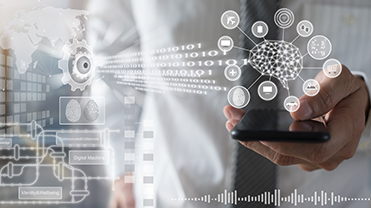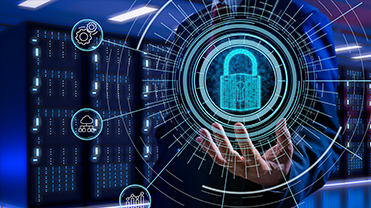5 emerging IoT mobile app trends
reshaping the future
In an era defined by connectivity and convenience, the powerful combination of the Internet of Things (IoT) and mobile applications has introduced a wave of transformative technological advancement. Whether it is smart thermostats enhancing our comfort, wearable fitness trackers monitoring our well-being, or a virtual assistant like Apple’s Siri, IoT-driven mobile apps have seamlessly integrated into our daily lives. Today, various sectors such as healthcare, agriculture, smart cities, and many others are already leveraging their capabilities to boost productivity and efficiency. As we delve into the future, this article unveils the five imminent trends shaping the evolution of IoT mobile applications, paving the way for a world that’s smarter, more efficient, and increasingly connected.
Exploring the intersection of IoT and mobile application
The use of mobile devices has become nearly ubiquitous, with approximately 6.4 billion smartphone users globally in 2022, as reported by Statista. These devices are well-suited for IoT integration, as they typically come equipped with technologies like WiFi, Bluetooth, Near Field Communication (NFC), and cellular data, which are essential for seamless integration with other smart devices. In light of the fact that several industries, including agriculture, manufacturing, and retail, are poised to exceed $1 trillion in investments within the IoT ecosystem by 2026, mobile applications seem to be a preferred channel of interaction between IoT devices and users.
Five major IoT mobile app trends to watch out for
5G technology
The future of IoT mobile applications is closely intertwined with the rapid advancement of 5G technology, which has a projected 85% network coverage by 2028. This widespread 5G accessibility promises ultra-fast data transfer speeds and low latency, revolutionising real-time IoT applications. This means faster, more efficient, and more reliable communication for IoT devices while accommodating the growing number of connected devices, paving the way for an IoT ecosystem that is more interconnected and data-rich than ever before. This enhanced connectivity will promote innovative mobile application developments across various industries, paving the path for integrated and more intelligent environments, improved energy management, and personalised user experiences.
artificial intelligence (AI) and machine learning (ML)
AI/ML and IoT are three of the most prominent technological trends, and their convergence is key to fostering a culture of mobile app innovation that can revolutionise businesses and our world. IoT apps are already making significant strides, such as predicting heart failures, offering personalised financial advice through robo-advisors, and managing smart homes. And this proliferation is poised to continue, with the AI in IoT market projected to exceed US$ 153.1 billion by 2033. As AI and ML advance, IoT applications will get smarter, analysing real-time data for actionable insights and automating decision-making. Personalisation will surge as AI adapts to user preferences, promising that future IoT apps will be characterised by enhanced intelligence, adaptability, autonomy, convenience, and efficiency.
For example, consider a shopping experience where customers can avoid tedious checkout lines entirely – and Amazon has accomplished precisely this using computer vision, deep learning algorithms, sensors, and their innovative Amazon Go app.
Augmented Reality (AR) and Virtual Reality (VR)
The integration of AR and VR with IoT is already pervasive, although it may often go unnoticed. Back in 2016, Pokémon Go showcased the potential of AR by placing digital creatures in the real world via smartphone cameras. Today, Nike and Home Depot offer virtual product trials on smartphones, and Wells Fargo offers real-time banking support via their AR app. On the VR front, educational institutions are leveraging it to provide fun training sessions for both students and teachers. From visualising food to controlling smart lights via biometrics, the potential for what AR and VR can deliver to IoT mobile technology is only the beginning. These technologies will continue to reshape our lifestyle and work environments, ushering in immersive, data-rich, and personalised experiences.
For instance, at Siemens’ Amberg Electronics Plant, a mobile app integrated with augmented reality visualises and processes engineering data for a comprehensive plant overview. This information empowers the operating personnel to utilise, edit, and process data as needed, fostering improved and more automated work processes.
IoT smart wearables
These intelligent devices, ranging from smartwatches and fitness trackers to augmented reality glasses, seamlessly integrate with mobile apps to offer users a wide range of functionalities. From monitoring health and fitness in real time to enhancing workplace productivity through AR applications, smart wearables are transforming how we interact with technology. The user-generated data empowers informed decisions about well-being, informs innovative solutions, and enhances user experiences, bridging the gap between individuals, businesses, and industries.
Like a smart ring from McLear, for example, which links to an iOS or Android app, allowing users to make contactless payments using NFC technology, and letting them track daily expenditures via the app.
In another use case, Softdel overcame field service productivity challenges with a cloud-based platform solution that leverages wearable devices and IoT to enhance the user experience.
In another use case, Softdel overcame field service productivity challenges with a cloud-based platform solution that leverages wearable devices and IoT to enhance the user experience.
Edge and cloud computing
Edge computing, with its proximity to data sources, reduces latency and enhances real-time decision-making for IoT devices. On the other hand, cloud computing offers the scalability and ample storage needed to manage the massive influx of data IoT generates. As these technologies evolve, we can expect IoT mobile apps to seamlessly balance the processing between edge and cloud, optimising efficiency, enhancing security, and unlocking new possibilities for IoT-driven innovations across various industries.
Softdel played a pivotal role in unifying a prominent global water heating solutions provider’s mobile apps into one cutting-edge, scalable app.
The integration of IoT and mobile applications is not merely an option; it is a strategic imperative for organisations and manufacturers seeking to thrive in an increasingly connected and data-driven world. This synergy not only boosts operational efficiency but also leads to better energy and cost savings, making it a cornerstone of sustainable and economically viable future technologies.
See how Softdel has revolutionised mobile app development throughout our 20+ years in the digital innovation space.






